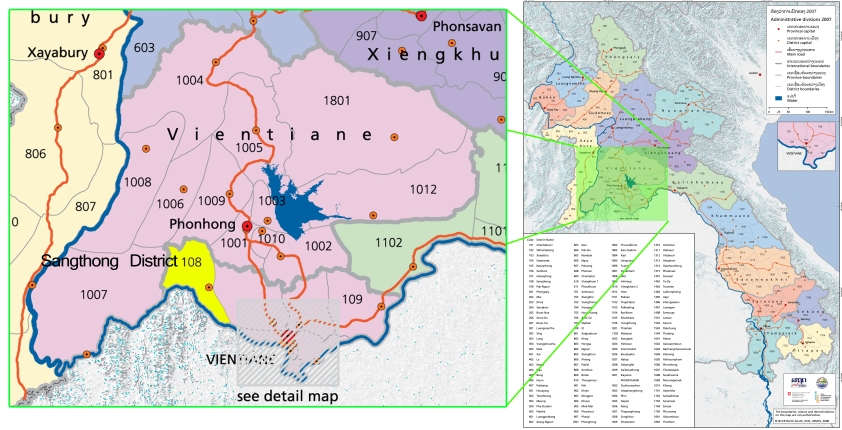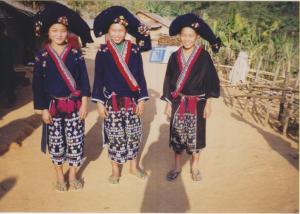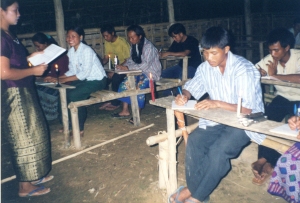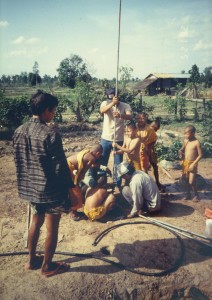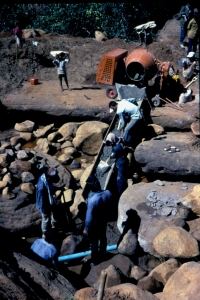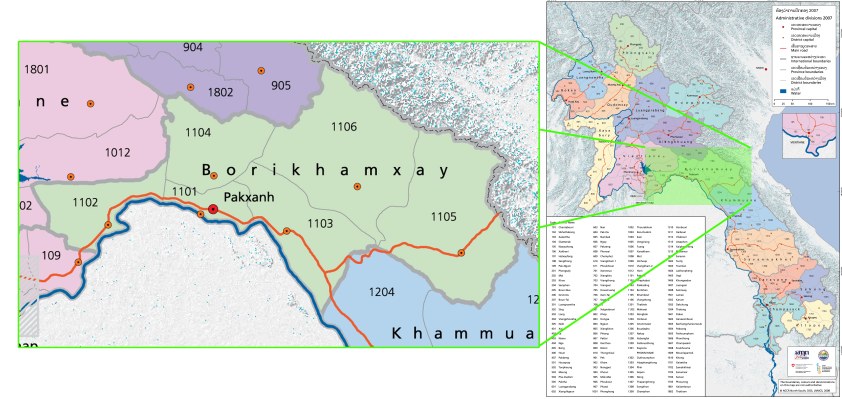
After completing the Integrated Rural Development Project (IRDP) in Houaphan and Phongsaly, MCC realized the difficulties related to introducing new growing techniques to subsistence farmers and felt it necessary to change their approach. MCC believed agriculture colleges would be a better fit, offering a place where new growing techniques could be tested without risking families’ food security, educating students with hands-on practice, building the capacity of college staff and strengthening the school’s curriculum.
After searching for a school to partner with, the Bolikhamxay Agriculture and Forestry College was chosen. MCC felt it was a good fit as the college had students coming from all over the nation and land available for experimentation plots.
Health Education Program – 2005 to 2008
In 2005 MCC began a project to improve the health of villagers in seven villages near the Muang Mai Health Center in Bolikhan District. MCC’s Integrated Agriculture Experimental Project at the Bolikhamxay Agriculture and Forestry College (BAFC) was in the same area. The project focused on the 5,000 people living in this area, most directly focusing on children, aged 6-10, in a school education program, mothers and their children under the age of five, in a nutrition program, and 14 village healthcare workers (VHW) in increased training opportunities.
MCC worked in five schools in the area and visited them a minimum of once every two months to provide education on relevant health concerns as indicated by current research, area dispensary staff, and school teachers. They sought to increase the health knowledge of the primary school children. Teachers were encouraged to continue this teaching and were given supplies to do so (e.g. soap to encourage hand-washing).
These visits included the distribution of health kits, puppet shows, and a review of hygiene practices. A valuable addition to school visits about preventing infection from intestinal worms was providing all students with medicine to treat worms. Studies in the area showed that as many as 90% of children had worms, and regular treatment to all children was recommended.
MCC visited each village a minimum of four times per year to conduct relevant health education programs. The team taught mothers to make soy milk, rice soup and vegetable soup. After the demonstration, all the children were weighed, and then ate some of the tasty products. These visits increased the participant’s health knowledge. They also increased the capacity of the area dispensary staff, Dr Vang and the health team, and village health volunteers to conduct health education and promotion in the villages.
Bounchan Khammoungkhoun (MCC Project Officer) worked closely with both the Health Education Program and the Integrated Agriculture Experimental Project. In 2006 she was based at BAFC.
MCC workers Ben and Alisa MacBride-Smith arrived in Laos in November 2004. Ben taught English at BAFC and Alisa worked in community health. Alisa contributed to the atmosphere at the clinic and to the workshops that she and the clinic staff presented.
David Bowman supported the agriculture project as a Soil Analyst/Expert. He travelled to Laos multiple times during the project for short term visits, conducting soil tests, recording soil composition and changes in the experimental plots and also helping in other MCC project areas.
After Ben and Alisa’s term finished, MCC continued to support dispensary staff to implement nutrition activities in the villages. In 2008, the project ended with the Integrated Agriculture Experimentation Project.
For more information see:
Ben and Alisa MacBride-Smith Blog (macbridesmith.blogspot.com)
Integrated Agriculture Experimentation Project –Phase I – 2005 to 2006
At the Bolikhamxay Agriculture and Forestry College (BAFC), a government run post-secondary institution.
The project’s overall goal was to provide improved agricultural production methods for villagers to ensure their food security and reduce poverty through sustainable alternative models of food production and extension worker development. This goal was met by building capacity of teachers and students in developing sustainable upland agriculture alternatives through experimentation plots at the college.
MCC worked in 3 main areas:
Trained students and teachers in experimentation plots at BAFC
Developed an agricultural curriculum to use at BAFC
Expanded experimentation with farmers in area villages
Phase I began in 2006 when experimental studies in sustainable upland farming were carried out on a 12.7 hectare experimentation plot area adjacent to the campus of Bolikhamxay Agriculture and Forestry College (BAFC). A dozen demonstration plots of cropping systems of rice, other staple crops, fruit trees and vegetables were developed. Many students practiced in these experimental plots.
To improve administrative processes between the college and MCC, Bounchan Khammoungkhoun (MCC Project Officer) was based at the college.
To improve the food security of poor families and expand experimentation with farmers, MCC personnel, teachers and students visited five villages in the area and held meetings with village farmers to discuss their needs, and how they could benefit from sustainable agriculture techniques being developed at the college. MCC conducted workshops in villages (Phengdy, Houykhoun, Xomxeoun, Songkhone and Khenyong) to demonstrate techniques of fruit tree propagation, rice cropping methods, rainy season vegetable growing and mushroom growing. As follow-up, they began experiments in these techniques with farmers in four of the villages.
Integrated Agriculture Experimentation Project – Phase II – 2007
In 2007 MCC emphasized establishing sustainability of the most promising cropping systems and implementing significant student practice in sustainable agriculture.
Major activities included building capacity of students in sustainable agriculture techniques, via practical training and extension work in nearby villages. 12 senior students received training by working with farmers in two local villages. Also, during the summer months senior students developed the promising sustainable cropping systems in the experimentation plots.
MCC gave in-house workshops to teachers on techniques for sustainable upland agriculture, and follow-up practical training to students in selected techniques.
MCC also supported teachers on several study tours to Thailand, Sangthong (to the existing MCC Project) and about Non-timber Forest Products (NTFP).
Phase II of the project was completed September 30, 2007. MCC arranged for an external evaluation of the project. Comments presented by the lead evaluator (Susan Kauffman, MCC Cambodia) were quite favourable, with many suggestions for future work. The evaluation final report was issued in November, 2007.
Integrated Agriculture Experimentation Project – Phase III – 2008 to 2009
The goal of Phase III, which began in 2008, was to provide every eligible student at BAFC with thorough practical training, in parallel with theory, in the major fundamental techniques required for sustainable upland agriculture and agro-forest. Activities were created by MCC staff and teachers using expertise developed in Phases I and II of this project.
In 2008 students learned through various field practices: Agro Forestry, Farmers’ Extension, Fish Raising, and Poultry Raising, Principles of Cropping, Tree Propagation, Mushroom Growing, Sustainable Agriculture, Fish Raising, Food Processing, Nursery, NTFP and Laboratory Skills.
In September 2008, MCC provided training for 14 teachers on farming extension techniques by using the training manual developed by Central Extension Training and Development Unit – LEAP (Lao Extension for Agriculture Project).
MCC staff and BAFC teachers worked together to strengthen the college’s curriculum. Though the college had curriculum covering agricultural theory, practical application was lacking. MCC helped test growing practices and create a curriculum from the results. In total, curriculum for 17 subjects was finished by the end of the project. The curriculum was approved by the Ministry of Agriculture for use at BAFC.
In 2009 teachers led I, II and II year students in practical studies of various subjects:
– Principles of sustainable agriculture – BE from fruit and vegetable
– Compost from rice straw – Mushroom growing
– Oilster mushroom growing – Principles of crops growing
– Vegetable growing – Soil improving by adding compost and BE
– Soil profile – Soil infiltration
– Integrated vegetable garden planning – Extension work
– Participant data collection – Village activities planning
Although the project was officially completed in February 2009, MCC continued to provide two scholarships for teachers completing their Bachelor’s degrees. Funding was provided in 2009-2010 and in 2010-2011.
MCC also continued the English Education Program at BAFC. Debi Vanduin, MCC Service Worker, taught English at BAFC from 2008 to 2009, after which it was determined not to continue the English Education Program at BAFC.


